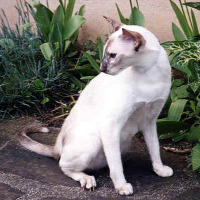 |
Seychellois |
|
TranslationFrancis Vandersteen |
||
OriginThe Seychellois is a cat breed originally from Thailand. |
| Its distinctive feature is a combination of colorpoint and bicolor patterns. |
| Patricia Turner, a British cat breeder, was inspired by reading the travel journals of explorers who spoke of an apparently indigenous cat breed with unique variations of white-patterned coats seen in the Seychelles. In the 1980s, Patricia set about recreating the appearance of the Seychellois cat by breeding bicolored Persians with Siamese and Orientals. Eventually, she succeeded in creating a cat that matched the description, but the breed was slow to gain ground. In recent years, however, bicolor Orientals and Siamese have grown in popularity, sparking renewed interest in the Seychellois breed. Seychellois cats share many of the same personality traits as Siamese. That is, they are intelligent, outgoing and social. They are a people-oriented breed who enjoy the company of humans and develop warm, affectionate bonds with them. Although they appreciate a modicum of “me”, Seychellois would prefer to spend the majority of their time around their people - be it on your lap, on your table or in your bed. However, while Siamese are considered very vocal, Seychellois tend to be a little quieter with a softer voice. When you first see a Seychellois cat, you'll quickly come to the conclusion that they're essentially a Siamese with white spots. Like Siamese, they are slender and elegant with a refined look and a well-muscled medium-sized body. The breed has a wedge-shaped head supported by a long, slender neck. They have large ears that are broad at the base and shaped at the top with a slightly rounded tip. The eyes are almond-shaped and slanted towards the nose. The color of the eyes is an important aspect of the breed, as they must be a clear, brilliant blue. The coat is short. To the touch, it is fine and silky. The extremities (head, legs and tail) are colored. The white patches, or Van pattern, is caused by the piebald gene. There is a variation in the amount of white produced by this gene, rated from 1 to 10, with 1 being almost black and 10 almost solid white. The degree of white spots in Seychellois can fall in the 7th, 8th or 9th year. Seychellois Septième (French for 7th) is white with a colored tail and large colored spots on the head, body and legs. Seychellois Huitième (French for 8th) is white with a colored tail and small colored spots on the head and legs only. Seychellois Neuvième (French for 9th) is white with a colored tail and small colored spots on the head. |






 English (United Kingdom)
English (United Kingdom)